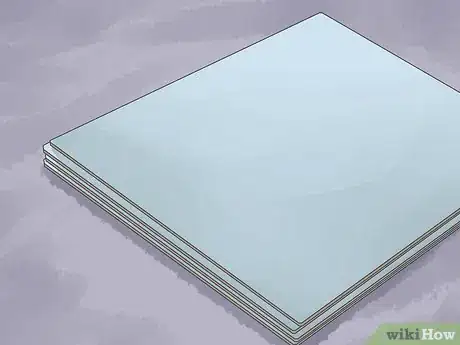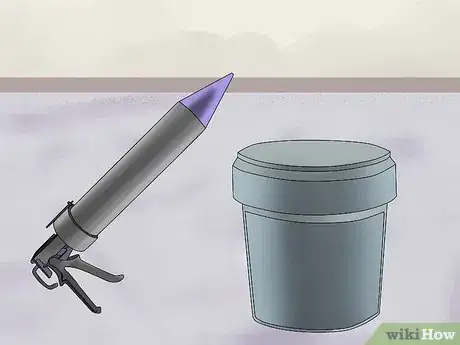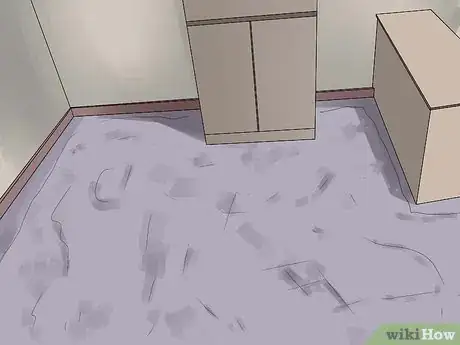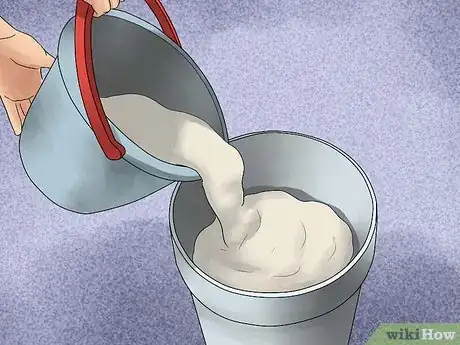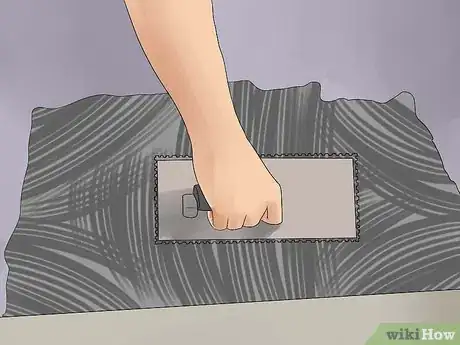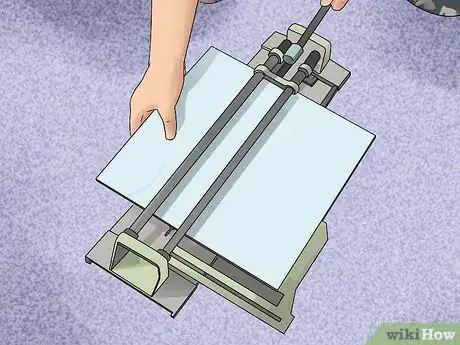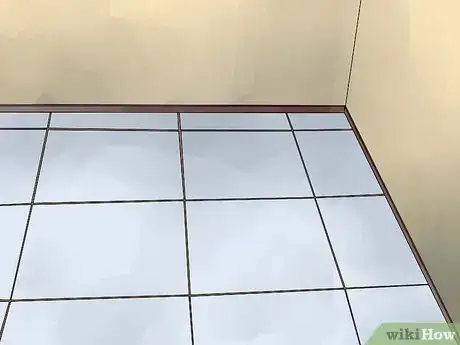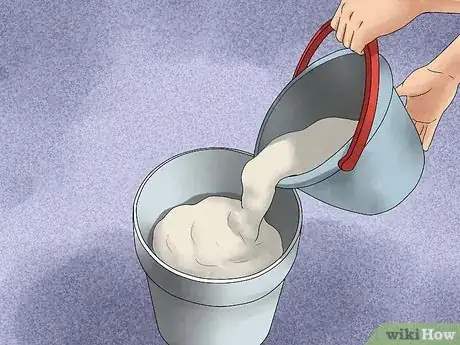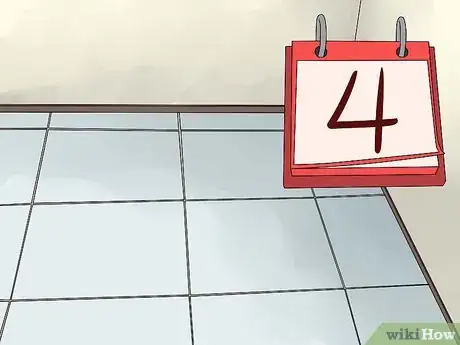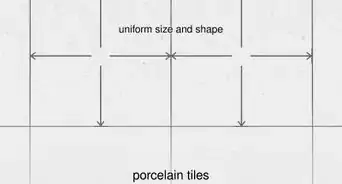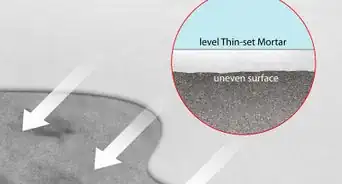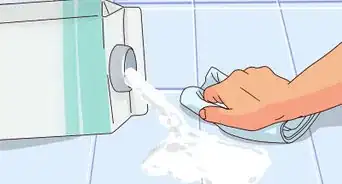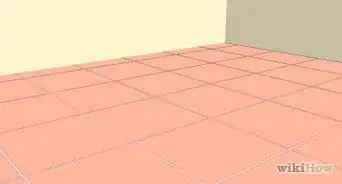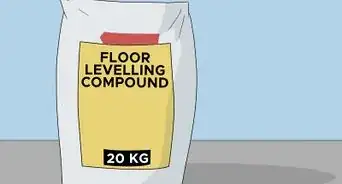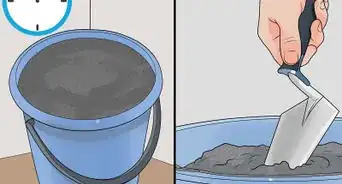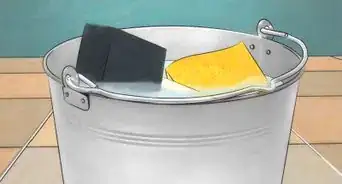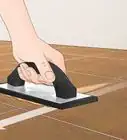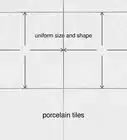This article was co-authored by Art Fricke. Art Fricke is a home renovation and repair specialist and the owner of Art Tile & Renovation based in Austin, Texas. With over 10 years of experience, he specializes in bathroom and kitchen renovations. Art focuses on a single contractor approach to customized renovation work, and performs projects such as installing custom tile showers, fixing tiled shower leaks, replacing cracked tiles, and installing floor and wall tile.
This article has been viewed 290,574 times.
Tiling your own bathroom floor can be a satisfying and cost-effective home repair project if you get the correct materials and plan your project in advance. With a little planning, anyone can do it. Keep reading to learn to prepare the foundation, lay the tile, and grout your floor so it will last for many years to come. Get tiling!
Steps
Getting the Right Materials
-
1Purchase tiles. Buy a tile that's durable and aesthetically pleasing to you. Purchase more tile than you'll need. A good rule of thumb is to get 15% more tiles to account for tiles you may need to cut to fit in narrow spaces and tiles that will break in the shipping process.[1] There are many different types of tile available:
- Vinyl tiles are also common, easy to install, and cheap. It's also self-adhering, so you won't need anything beyond the tiles themselves to do it yourself. Other kinds of tile will require more work and materials. If you use vinyl, you won't need to buy anything else. Just follow the adhering instructions on the package and following the alignment guidelines below.
- Plastic laminate and linoleum tiles generally come in planks, rather than tiles, but are sometimes popular. They are also more expensive, ranging upward of 4 dollars per square foot.
- Other tiles made of wood, cork, stone, or glass are also available but tend to be more expensive. These require other sorts of polyurethane coatings to avoid dings and dents, but are a good option if you like the look.
-
2Purchase thin-set mortar and grout. To lock the tiles in and create a solid floor for your bathroom, you'll need to first layer a thin amount of mortar to set the tiles and grout to connect them to one another.
- Mortar usually comes in two varieties, pre-mix and unmixed mortar that comes in a box. All you need to do to mix it is add water and the pre-mixed tubs are usually more expensive, but buy whichever variety works for you.
Advertisement -
3Buy tools. In addition to the tiles, mortar, and grout, you'll also need:
- Measuring tape
- Cement board
- Utility knife
- 2 large buckets and a large sponge
- Notched trowel
- Hammer and roofing nails
- Tile cutter or wet saw
- Tile spacers
- Level, square, and chalk line
- Grout float and sealant
- Knee pads
Laying the Foundation
-
1Prepare the floor. Make sure the surface you're going to tile is swept and clean of any debris, especially if you're in the middle of more major renovations or construction.
- Make certain the existing floor is flat, solid, and well bonded to the sub-floor. The floor and subfloor together should be at least 1-1/8" thick.
-
2Mix a batch of thin-set mortar. Follow the manufacturer directions, mixing the appropriate amount of water with the mortar in a bucket. The mortar should be thick, a similar consistency to mud, but not so thick that is doesn't fall off a trowel.[2]
- Don't mix more thin-set than you can use within an hour, or it will begin to dry out.
-
3Spread a layer of thin-set on the sub-floor with the notched trowel. Spread the mortar quickly, but also evenly. Use firm sweeping motions with the trowel.
-
4Cut the cement board to fit the space. If you want to reinforce the floor with cement board, score it with a utility knife before laying it over the thin-set mortar.[3]
- Pound in roofing nails along the edge to secure the backer board to the floor. Continue until the floor is covered and apply a thin layer of thin-set mortar over the joints.
-
5Wait until the next day to begin laying tile. In the meantime, you can prepare the reference lines to make sure the tile will be laid evenly.
-
6Establish a straight vertical and horizontal reference line from the center of the room. If you simply start laying tile along a crooked wall, it will look really crooked by the time you reach the opposite wall, so you need to use a mason's chalk line (a piece of string covered with chalk dust that you can snap into place) to establish easily-removable reference lines.
- Identify the most visible wall when you walk into the room. This is the wall with the longest area of continuous tile.
- Determine a 90-degree angle from that wall, using a square, and snap a chalk line across the room.
- Use the square again to mark a perfect 90-degree angle from that chalk line and snap another chalk line that's perpendicular to the first one. Now you have two intersecting chalk lines as a reference to lay the first tile.
Laying Tile
-
1Lay out a single horizontal and vertical row of tiles across the floor along the chalk reference lines. Shift the tiles, if needed, so any cuts that must be made by the wall are against the least noticeable wall. You also don't want cut tiles at the entrance to the bathroom, so adjust the tiles so cuts are against the far wall.
- You can snap additional chalk reference lines, once the tile layout is finalized, if you wish.
-
2Set the first tile in the far corner of the room and work towards the doorway. You won't want to step on the newly laid tile before the mortar has a chance to dry. Work on laying the tile in small sections at a time.
- Mix up a small batch of thin-set mortar and spread a thin layer on the cement board with the notched trowel.
- Lay several pieces of tile with tile spacers to establish even grout lines.
- Firmly press the tile into the mortar so there are no air bubbles underneath.
- Set a level across the top of the tiles to make sure they are perfectly flat.
-
3Cut tiles with a tile cutter or wet saw, if necessary, to fit along the wall. As you work toward the walls, you may not be able to use a perfect number of tiles. You may also need to make cuts for tiles that sit around toilets and other rounded objects in the floor.[4]
-
4Allow the thin-set to dry for at least a day. Follow the instructions recommended by the manufacturer before grouting.
Grouting Bathroom Floor Tile
-
1Pull the tile spacers out from between the tiles before adding grout. Mix the sanded grout with water in a bucket, according to the manufacturer directions.
-
2Scoop some grout onto the file floor with a trowel. Firmly press it into the grout lines with the grout float, working in small sections at a time. Remove the excess grout from the surface of the tile before it has a chance to dry.[5]
- Fill a second bucket with water and use it to wet the large sponge with rounded corners. Wring out the sponge and then wipe over the tile so that you are moving at a diagonal to the grout lines. If you wipe parallel to the grout lines, you might gouge out some of the grout and leave an uneven surface. Rinse the sponge in the bucket of water and repeat until all the grout is removed from the surface of the tile.
-
3Wait at least 2 days for the grout to cure before sealing it. Sometimes its smart to leave a humidifier on during the two days you're letting it sit, to help the grout gain in strength.[6]
Expert Q&A
Did you know you can get expert answers for this article?
Unlock expert answers by supporting wikiHow
-
QuestionWhy can it be difficult to color match grout?
 Art FrickeArt Fricke is a home renovation and repair specialist and the owner of Art Tile & Renovation based in Austin, Texas. With over 10 years of experience, he specializes in bathroom and kitchen renovations. Art focuses on a single contractor approach to customized renovation work, and performs projects such as installing custom tile showers, fixing tiled shower leaks, replacing cracked tiles, and installing floor and wall tile.
Art FrickeArt Fricke is a home renovation and repair specialist and the owner of Art Tile & Renovation based in Austin, Texas. With over 10 years of experience, he specializes in bathroom and kitchen renovations. Art focuses on a single contractor approach to customized renovation work, and performs projects such as installing custom tile showers, fixing tiled shower leaks, replacing cracked tiles, and installing floor and wall tile.
Home Renovation & Repair Specialist Grout will change shade over time as it oxidizes and also as it absorbs dirt and grime. Its color can also change as it gets cleaned over time. So even if you know the exact brand and color and type of grout that was used previously, it can sometimes be difficult to get it to match if you're trying to do a patch in an existing tile that was done more than just a year or two previous. Though it can be difficult, there are a couple tricks that you can use to dirty up grout a little bit or brighten it up to ease the transition from one slight shade to another.
Grout will change shade over time as it oxidizes and also as it absorbs dirt and grime. Its color can also change as it gets cleaned over time. So even if you know the exact brand and color and type of grout that was used previously, it can sometimes be difficult to get it to match if you're trying to do a patch in an existing tile that was done more than just a year or two previous. Though it can be difficult, there are a couple tricks that you can use to dirty up grout a little bit or brighten it up to ease the transition from one slight shade to another. -
QuestionWhat is the cheapest way to renovate a bathroom?
 Art FrickeArt Fricke is a home renovation and repair specialist and the owner of Art Tile & Renovation based in Austin, Texas. With over 10 years of experience, he specializes in bathroom and kitchen renovations. Art focuses on a single contractor approach to customized renovation work, and performs projects such as installing custom tile showers, fixing tiled shower leaks, replacing cracked tiles, and installing floor and wall tile.
Art FrickeArt Fricke is a home renovation and repair specialist and the owner of Art Tile & Renovation based in Austin, Texas. With over 10 years of experience, he specializes in bathroom and kitchen renovations. Art focuses on a single contractor approach to customized renovation work, and performs projects such as installing custom tile showers, fixing tiled shower leaks, replacing cracked tiles, and installing floor and wall tile.
Home Renovation & Repair Specialist
Warnings
- Cutting tile and mixing mortar can kick a lot of harmful particulate in the air. Ventilate the area or consider wearing breathing protection.⧼thumbs_response⧽
Things You'll Need
- Measuring tape
- Cement board
- Utility knife
- Thin-set mortar
- 2 large buckets
- Notched trowel
- Roofing nails
- Hammer
- Square
- Chalk line
- Tile
- Tile cutter or wet saw
- Tile spacers
- Level
- Large sponge
- Grout
- Grout float
- Grout sealant
- Knee pads
References
- ↑ http://www.bobvila.com/articles/7725-bathroom-floor-tile-which-is-best-for-your-bath/
- ↑ http://www.diynetwork.com/how-to/how-to-install-a-tile-bathroom-floor/index.html#step3
- ↑ https://www.diynetwork.com/how-to/skills-and-know-how/masonry-and-tiling/how-to-install-a-tile-bathroom-floor
- ↑ https://www.familyhandyman.com/floor/install-a-ceramic-tile-floor-in-the-bathroom/
- ↑ https://www.familyhandyman.com/floor/install-a-ceramic-tile-floor-in-the-bathroom/
- ↑ http://www.askthebuilder.com/how-to-grout-tile/
- ↑ Art Fricke. Home Renovation & Repair Specialist. Expert Interview. 1 July 2020.
About This Article
To tile a bathroom floor, start by spreading a layer of thin-set mortar onto the entire subfloor with a notched trowel. Then, place cement board on top of it to reinforce the floor. After the thin-set has dried for 2 days, work in small sections to spread more thin-set over the cement board and lay the tile on top of it. Once you’ve worked your way from the corner of the room to the door, allow the mortar to set for another day. Finally, use a grout float to fill the spaces between the tiles with grout and let it cure for 2 days before sealing the floor. For tips on how to cut tiles with a tile cutter or wet saw, read on!
